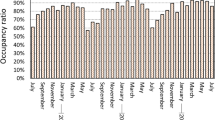Abstract
Market mechanisms are gaining increasing acceptance all over the world as a way of making more efficient use of scarce water resources. Designing regulatory frameworks that ensure both inter- and intra-temporal efficient allocations is a daunting task, especially if supply is stochastic and there is ample storage capacity. In addition to defining tradable rights, specific provisions must regulate the use of reservoirs. Commonly, water statutes include provisions that establish asymmetries regarding the allocation of water, and market restrictions that ban water trading across different users. In this article, we use data collected in a laboratory to test two specific market regulations included in the 1999 Water reform in Spain. First, junior right holders are not allowed to buy water from senior users. Second, the law does not explicitly define water rights over units left in reservoirs for the following season. Results suggest that trading restrictions among water right holders lead to welfare losses for senior users. It is shown that removing this restriction would increase senior right holders’ benefits, without reducing those of junior users. Results show that defining water rights over saved units across periods would increase the average stock levels of reservoirs, and reduce market price instability. The lessons learned from the Spanish experience are applicable to settings characterized by unstable natural water supply and the availability of large storage facilities.
Similar content being viewed by others
References
Ariño G, Sastre M (2007) Sector regulation and liberalisation. Legal and practical issues. In: Garrido A, Llamas MR (eds) Water policy in Spain. Resources for the Future, Washington, D.C. in preparation
Bell R, Beare S (2000) Salinity targets in the Murray Darling Basin. Aust Commodities 7(2):348–356
Bjornlund H, McKay J (1998) Factors affecting water prices in a rural water market: a south Australian experience. Water Resour Res 34(6):1563–1570
Bjornlund H (2003) Efficient water market mechanisms to cope with water scarcity. Water Resour Dev 19(4):553–567
BOE (1999) Ley 46/1999, de 13 de diciembre, de modificación de la Ley 29/1985, de 2 de agosto, de Aguas. Boletín Oficial del Estado. [Act 46/1999, of 13 December, amending the Water Act 29/1985, of 2 August. Official State Gazette, Madrid]
Brown MB, Forsythe AB (1974) Robust tests for the equality of variances. J Am Stat Assoc 69:364–367
Calatrava J, Garrido A (2005a) Spot water markets and risk in water supply. Agric Econ 33:131–143
Calatrava J, Garrido A (2005b) Modelling spot water markets under uncertain water supply. Eur Rev Agric Econ 32(2):119–142
Calatrava J, Garrido A (2006) Water markets and customary allocation rules: explaining some of the difficulties of designing formal trading rules. J Econ Issues XL(1):27–44
Carter HO, Vaux Jr HR, Scheuring AF (eds) (1994) Sharing water scarcity. Gainers and losers in water marketing. University of California Agricultural Issues Center, Davis
Diao X, Roe T (2003) Can a water market avert the “double-whammy” of trade reform and lead to a “win-win” outcome? J Environ Econ Manage 45:708–723
Dinar A, Letey J (1991) Agricultural water marketing, allocative efficiency and drainage reduction. J Environ Econ Manage 20:210–233
Dudley NJ (1992) Water allocation by markets, common property and capacity sharing: companions or competitors? Nat Resour J 32:757–778
Easter KW, Rosegrant MW, Dinar A (eds) (1998) Markets for water: potential and performance. Kluwer Academic Publishers, New York
Garrido A, Iglesias E, Blanco M (1996) Análisis de la actitud de los regantes ante el establecimiento de precios públicos y de mercados de agua. Revista Española de Economía Agraria 178:139–162
Garrido A (2000) La reforma de la Ley de Aguas. Iuris 39, Mayo, 44–51
Garrido A, Llamas MR (eds) (2007) Water Policy in Spain. Resources for the Future, Washington, D.C. in preparation
Gómez Ramos A, Garrido A (2004) Formal risk-sharing mechanisms to allocate uncertain water resources: the case of option contracts. Water Resources Research 40(12)
Giansante C, Babiano L, Aguilar M, Garrido A, Gomez A, Iglesias E, Lise W, Del Moral L (2002) Institutional adaptation to changing risk of water scarcity in the lower Guadalquivir Basin. Nat Resour J 42(3):521–563 Summer
Hearne RE, Easter RR (1998) Economic and financial returns from Chile’s water markets. In: Easter KW, Rosegrant MW, Dinar A (eds) Markets for water: potential and performance. Kluwer Academic Publishers, New York, pp 159–172
Howitt RE (1998) Spot prices, option prices, and water markets: an analysis of emerging markets in California. In: Easter KW, Rosegrant MW, Dinar A (eds) Markets for water: potential and performance. Kluwer Academic Publishers, New York, pp 119–139
Iglesias E, Garrido A, Gómez-Ramos A (2003) Evaluation of drought management in irrigated areas. Agric Econ 29:211–229
Matthew OP, Scuderi L, Brookshire D, Gregory K, Snell S, Krause K, Chermak J, Cullen B, Campana M (2001) Marketing western water: can a process based geographic information system improve reallocation decisions. Nat Resour J 41:329–371
Miller R (2002) Don’t let your robots grow up to be traders. Working Paper, Miller Risk Advisors
Murphy JJ, Dinar A, Howitt RE, Rassenti SJ, Smith VE (2000) The Design of “Smart” water markets institutions using laboratory experiments. Environ Resour Econ 17:375–394
Olmstead J, Sunding D, Parker D, Howitt R, Zilberman D (1997) Water Marketing in the ‘90s: entering the electronic age. Choices (Third Quarter) 15–19
Rosegrant MW, Ringler C, Mckinney DC, Cai X, Kellerr A, Donoso G (2000) Integrated economic-hydrologic water modelling at the basin scale: the Maipo river basin. Agric Econ 24:33–46
Smith VE (2003) Constructivist and ecological rationality in economics. Am Econ Rev 95(3):465–508
Weinberg MC, King CL, Wilen JE (1993) Water markets and water quality. Am J Agric Econ 75(2):278–291
Author information
Authors and Affiliations
Corresponding author
Rights and permissions
About this article
Cite this article
Garrido, A. Water markets design and evidence from experimental economics. Environ Resource Econ 38, 311–330 (2007). https://doi.org/10.1007/s10640-006-9077-0
Received:
Accepted:
Published:
Issue Date:
DOI: https://doi.org/10.1007/s10640-006-9077-0




